Further images
-
(View a larger image of thumbnail 1)
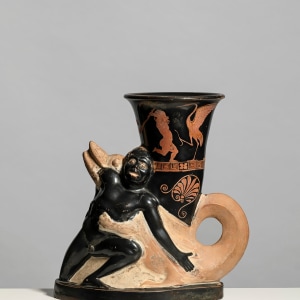
-
(View a larger image of thumbnail 2)
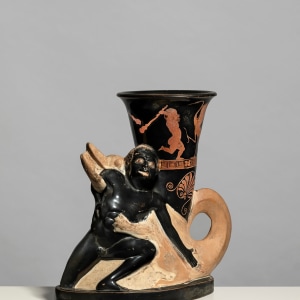
-
(View a larger image of thumbnail 3)
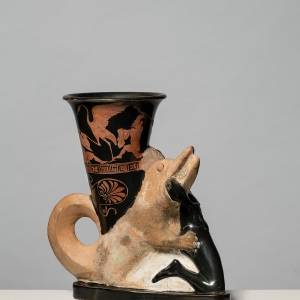
-
(View a larger image of thumbnail 4)
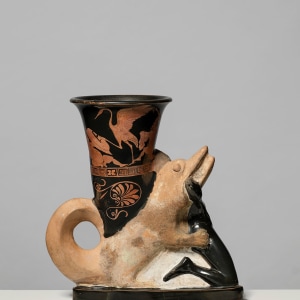
-
(View a larger image of thumbnail 5)
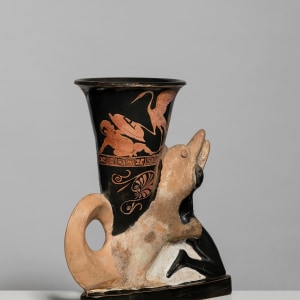
-
(View a larger image of thumbnail 6)
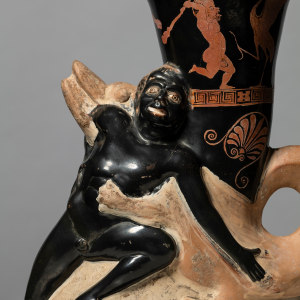
-
(View a larger image of thumbnail 7)
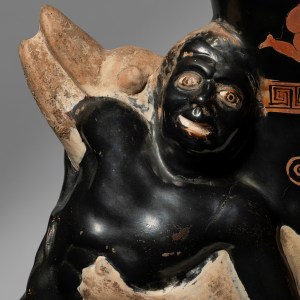
-
(View a larger image of thumbnail 8)
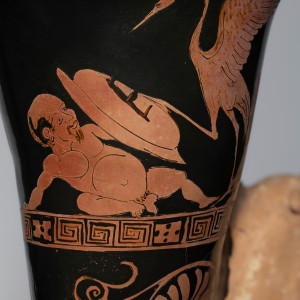
-
(View a larger image of thumbnail 9)
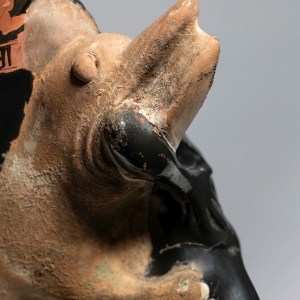
Around the neck of the vessel is painted a playful Geronomachia, a battle between pygmies and storks. The balding, bearded pygmies are nude and brandish knobbled clubs, their bellies swollen, their bodies muscular. One side shows a pygmy swinging his club over his head with both hands, preparing to strike a blow upon a tall crane which is lifting its talonned foot towards the pygmy’s stomach in an attempt to push him backwards. To the right of this duo is a pygmy lying on the ground, propping himself up with his right arm and brandishing a shield with a victory tripod device, to defend himself against a crane who is mid-attack, its wings raised. Behind this crane a further pygmy jumps to his companion’s aid, wielding a club in his right hand, a chlamys draped over his left forearm, as he prepares to strike the crane from behind. Beneath the scene is a border of meanders, underneath which are scrolling tendrils and palmettes.
The body is made from a two part mould, the hollow foot formed separately, the neck created on the potters wheel. Intact, the applied green now largely worn away.
The term ‘plastic vase’ derives from the Greek verb ‘plassein’ meaning ‘to mould’. Moulded vases like the present example have been found in temple deposits and tombs and are not thought to have been used in everyday life. Though they were created in Athens they have been found in Etruria, Sudan, Persia and Sicily, and evidently were highly valued objects that were traded around the Greek world. The technique used for creating plastic vases meant that it was easy to make multiple examples of the body, and then to vary the decoration of the red-figure scenes; the moulded section of this vase has twelve other known examples, all with different red-figure decoration.
The Geronomachia was a popular theme in antiquity and was considered a rather jovial subject matter. It was less politically charged than other mythical battle scenes which often symbolised the victory of the civilised world over the barbaric; West over East.
Sotades is considered to be the first person to represent the crocodile in Greek art; a wild and exotic animal that was representative of Nilotic scenery, the same backdrop in which the Geronomachia is often shown to take place.
John Boardman wrote on Sotades, and called him an artist of great delicacy and imagination. He owned his own workshop, and even in antiquity was considered to produce some of the finest wares. His renown was so great that they copied his rhyta in Southern Italy for a century after their initial production. Almost all of the wares produced at the workshop relate to ritualistic drinking and libation pouring. Discussions on Sotadean vases have been widely published, and there are several compendiums of his work. The greatest of these was conducted by Beazley who has attributed over seventy works to his name.
Provenance
Professor B.S. (1903-1992), Lugano, Switzerland; acquired 1st April 1957 from Münzen and Medaillen, thence by descent until 2023
Literature
For another example of the mould see William Friedrich Hamdorf, Hauch Prometheus: Meisterwerke in Ton (Munich, 1996), no.227. Also see D. Williams, “Sotades: Plastic and White,” in S. Keay and S. Moser, eds, Greek Art in View, Essays in Honour of Brian Sparkes (Oxford, 2004), p.102, fig.7.7
For a similar mould, and scene of pygmies see Herbert Hoffmann, Sotades, Symbols of Immortality on Greek Vases (Oxford, 1997), figs.11-12
Publications
Herbert Hoffmann, ‘“Crocodile Love” (the Dionysian Connection): Further Studies in the Iconology of Athenian Vase Painting’, Hephaistos: New Approaches in Classical Archaeology and Related Fields, 1992-1993, pp.151-153, figs.16-18
Herbert Hoffmann, Sotades, Symbols of Immortality on Greek Vases (Oxford, 1997), fig.10








